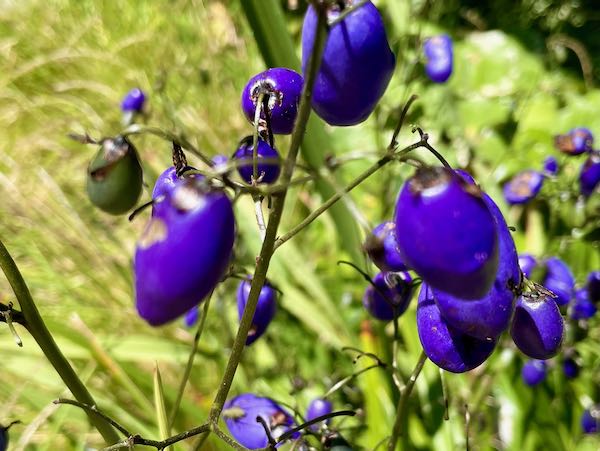Dianella caerulea, commonly known as Blue Flax-lily, Blueberry Lily, or Paroo Lily, is a captivating herbaceous perennial that belongs to the Asphodelaceae family of plants. Although it was first propagated in England in 1783, its native habitat extends across eastern Australia and Tasmania.
The plant was officially described by John Sims in Curtis’s Botanical Magazine in 1802. The genus name, Dianella, was chosen in honor of Diana, the Roman goddess, while “caerulea” derives from the Latin word for “blue,” referring to the plant’s striking blue flowers. These names reflect the plant’s beauty and significance.
Dianella caerulea grows from underground rhizomes, forming clumps and gradually spreading over time. It features sword-shaped green leaves that can reach a height of 70cm or 28 inches. The leaves may have either straight edges or toothed margins, adding an attractive texture to the plant. In spring and summer, Dianella caerulea produces clusters of delicate blue flowers adorned with yellow-brown anthers. After flowering, bright blue-violet berries appear, which not only enhance the visual appeal but are also edible. Birds are particularly drawn to these berries, making the plant an excellent choice for attracting wildlife.
How to grow Dianella caerulea:
In terms of cultivation, Dianella caerulea is a hardy and long-lasting plant. Here are some guidelines for successfully growing it:
Sun Exposure: Plant Dianella caerulea in a location that receives either full sun or partial shade. It is adaptable to different light conditions.
Soil Requirements: Provide the plant with moist, fertile, humus-rich, and well-drained soil. However, Dianella caerulea is known to tolerate slightly damp conditions, making it suitable for areas with excess moisture. It thrives in various soil types.
Ideal for Rock Gardens: Due to its compact and clumping growth habit, Dianella caerulea is well-suited for rock gardens. Its attractive foliage and vibrant blue flowers create an eye-catching display.
Propagation: This plant can be propagated by either seeds or division. Collect ripe berries and extract the seeds for sowing. Alternatively, divide mature clumps to create new plants.
Disease and Pest Resistance: Dianella caerulea is generally disease-free and pest-free, making it a low-maintenance plant. However, it is always beneficial to monitor the plant for any signs of pests or diseases and take appropriate action if needed.
By following these care instructions, you can cultivate Dianella caerulea successfully. Its stunning blue flowers, ornamental berries, and hardy nature make it a desirable addition to gardens, landscapes, or rockeries.

Daniella caerulea has six known varieties:
Dianella caerulea encompasses six known varieties, each with its distinct characteristics. These variations include differences in height, leaf color, and growth habit. Choose the variety that best suits your preferences and growing conditions.
Dianella caerulea presents several distinct varieties, each exhibiting its own unique characteristics. The var. assera is a taller variety, while var. caerulea and var. cinerascens feature pale-grey leaves. Another variety, var. petasmatodes, forms a mat-like growth habit. Var. producta stands out as a taller variety with a perianth that ranges in color from greenish-white to blue. Var. protensa, on the other hand, is a smaller variety commonly found in sandy soils. Lastly, var. vannata is yet another taller variety within the Dianella caerulea family.



